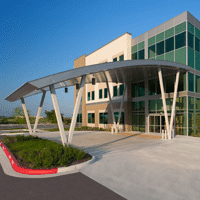Kerry Angus started Onair Development after seeing an opportunity to improve conditions for medical providers. As a healthcare attorney, he watched physician reimbursements decline, and he eventually decided it was time to launch a new model of medical office space ownership to help with doctors increasing costs.
“We make tenants our partners in the deal and allow them to acquire ownership by using their long-term lease as currency,” Angus explains. Onair Development’s typical deal size is 30,000 to 60,000 square feet, with about 60 percent of projects focused on ground-up construction and the remainder composed of acquisition and repositioning of existing facilities.
Onair Development specializes in real estate development that offers physicians and other professionals benefits that many hospitals do not, such as control over services offered, complementary specialists among the project’s tenants, and an ownership stake in the project.
Developments bring together specialists with primary-care physicians and urgent-care services as well. It’s a one-stop shop that provides patients convenience and tenants a robust business environment. The formula is successful because Onair has the real estate expertise and much of the capital, which allows the physicians to focus on healthcare.
Founded in 2009, by 2011 Onair Development was named Austin’s number one medical-real-estate-development firm and fifth in overall real estate developers by volume. The market was difficult during those years, but it has grown in revenue each year, Angus says.
Onair is now getting clarity on some of the real estate finance issues that have been plaguing the country for the past few years. Because of that insight, the company has been able to expand its footprint as well as its project portfolio.
A recent project, Kyle Medical Plaza, is located in the high-growth area of Kyle, Texas, about 20 miles south of Austin. The facility is less than a mile from a nearby hospital but outside any ancillary restrictions the hospital might try to impose.
Another project, the Riverplace Medical Plaza is opening in summer 2013, but instead of being located near other care facilities, Riverplace is situated outside one of Austin’s gated communities for convenience.
“I’m seeing a real shift in medical providers wanting to be closer to their patients and oftentimes closer to where they live,” Angus says. “It’s about bringing medical services to the patients and making it convenient for them.” While much of Onair’s focus has been on Central Texas, it’s branching out and taking other development opportunities across the South.
Onair Development seeks to develop medical facilities where provider tenants have an ownership stake. It brings medical providers together in a model that aims to boost revenue, not control it.
“I saw the tension between physician groups and hospitals,” Angus says, “where the hospitals wanted to control the ancillaries, but doctors needed to capture those in order to maintain their income levels.”
Onair Development often partners with other companies such as Schneider Halls, an architecture firm with a background in the healthcare niche. Angus says that Schneider Halls specialized in an area where it saw a need.
In part because of its expertise in healthcare facilities, Onair chose Schneider Halls as the lead architect for the Riverplace project. Angus says the result is a cost-effective and efficient building that is also aesthetically pleasing and has a lot of touches to enhance the livability for tenants and patients.

